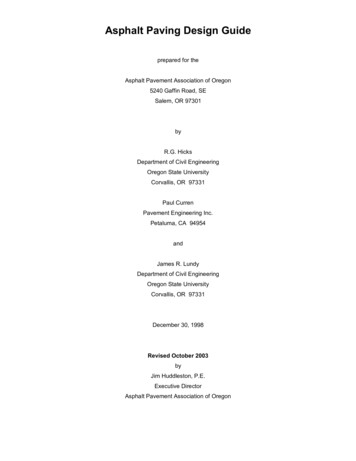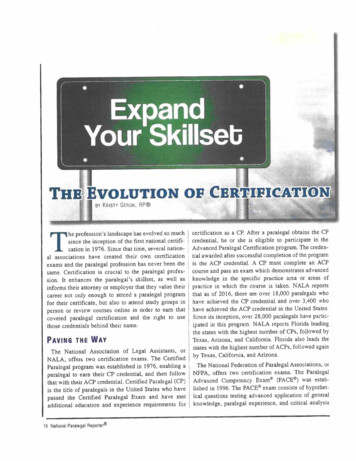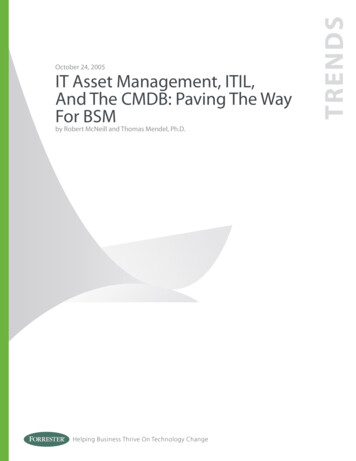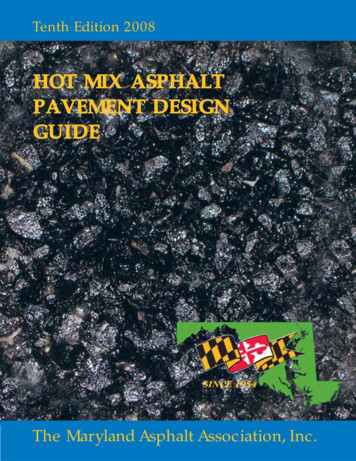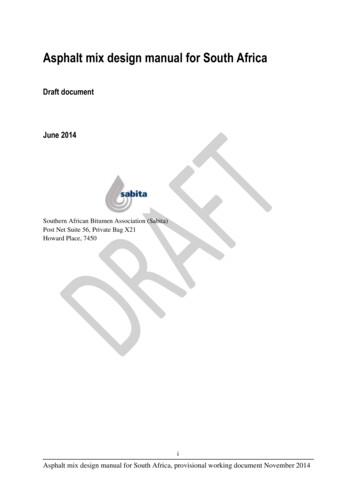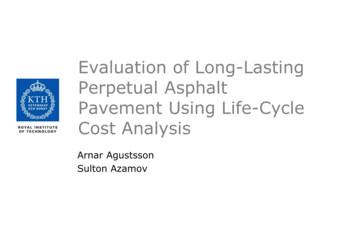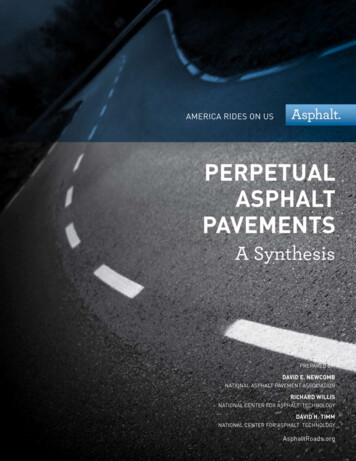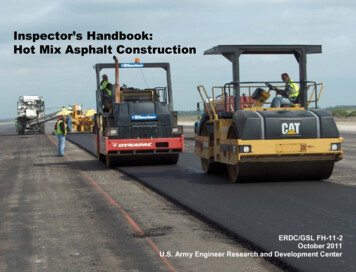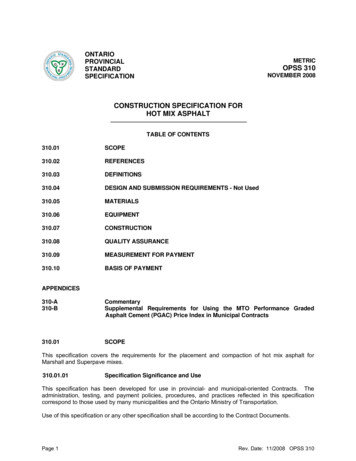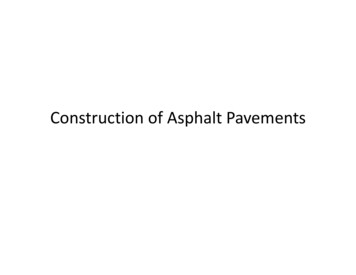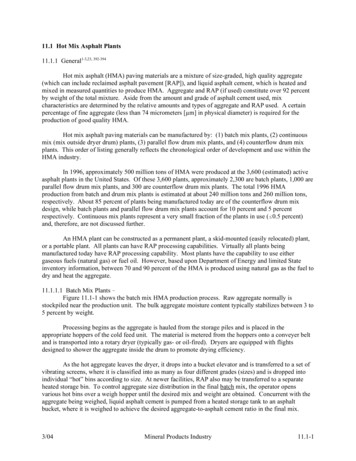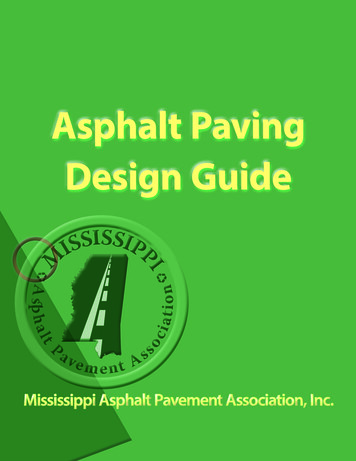
Transcription
I t ionciaPave msoMSSISIPPSIA sp h a l t Asphalt PavingDesign GuidesAentMississippi Asphalt Pavement Association, Inc.
Table of ContentsI t ionciaPave msoMSSIPISSIPA sp h a l t History Of Asphalt.3Asphalt Pavement - Ideal Choice.4General Planning.4Aggregate Base Course .6Asphalt Pavement Surface.7Sample Specifications .7Surface Course Specifications .8Considerations.10Design For Parking Lots. 11sAent
History Of Asphaltassociation representing the asphalt pavement producersof Mississippi. The mission has changed over the life of theassociation as needed. The need for public support of highwayThe story of asphalt begins thousands of years before theconstruction and maintenance neccesitated the primary focusfounding of the United States. Asphalt occurs naturally in bothbe on legislative issues affecting the industry. It is our wish thisasphalt lakes and in rock asphalt (a mixture of sand, limestonemanual will serve you well and we thank you for your interest inand asphalt).quality pavements.The ancient Mesopotamians used it to waterproof templebaths and water tanks. The Phoenicians caulked the seams oftheir merchant ships with asphalt. In the days of the Pharaohs,The national energy crisis underscored the need forEgyptians used the material as mortar for rocks laid along theconservationof natural resources. Since that time, an increasingbanks of the Nile to prevent erosion, and the infant Moses’amountofrecycledasphalt has been incorporated in mixes.basket was waterproofed with asphalt.Today, asphalt pavement is America’s most recycled materialwith more than 70 million metric tons of asphalt paving materialis recycled each year.The first recorded use of asphalt as a roadbuilding materialin Babylon. The ancient Greeks were also familiar with asphalt.The word asphalt comes from the Greek” asphaltos,” meaningNAPA established the National Center for Asphalt“secure.” The Romans used it to seal their baths, reservoirs andTechnology (NCAT) at Auburn University, Alabama, providingaqueducts.a centralized, systematic approach to asphalt research. NCATrecently opened a new research center and test track and is nowthe world’s leading institution for asphalt pavement research.Thomas Telford built more than 900 miles of roads inMAPA partnered with the Mississippi Department ofScotland, perfecting the method of building roads with brokenTransportation (MDOT) in the implemention of the SUPERPAVEstones. His contemporary. John Loudon McAdam, used brokenDesign Processs which is one of the design procedures featuredstone joined to form a hard surface to build a Scottish turnpike.in this manual. This has been a long untraveled process thatLater, to reduce dust and maintenance, builders used hot tarculminated in the superior pavements we produce today.to bond the broken stones together, producing “tarmacadam”Mississippi was the first state in the nation to adopt the systempavements.which is now the standard in most all states. No state has beenmore on the cutting edge of asphalt technology than Mississippi.We are very proud of being recognized as a National Leader inFrederick J. Warren filed a patent for “Bitulithic” pavement, Asphalt Technology advancements.a mixture of bitumen and aggregate (“bitu” from “bitumen” and“lithic” from “lithos,” the Greek word for rock). The first modernasphalt facility was built in 1901 by Warren Brothers in EastThe EPA announced that asphalt plants are no longer onCambridge, Mass.its list of industries considered major sources of hazardous airpollutants.Asphalt design has evolved in recent years to the point thatDuring World War II, asphalt technology greatly improved, we can provide a pavement structure that will perform in anyspurred by the need of military aircraft for surfaces that could condition.stand up to heavier loads.Ultimately, the goal of this publicaton is to provide youthe customer with enough information to develop your ownbest practices guide and to share practical experience to furtherCongress passed the Interstate Highways Act, allotting 51 improve the performance of your pavements.Aspects perceived by users as needing refinement. Thisbillion to the states for road construction. Contractors neededbigger and better equipment. Innovations since then include manual summarizes what changes have been made to theelectronic leveling controls, extra-wide finishers for paving two Superpave system and the rationale for those changes.lanes at once and vibratory steelwheel rollers.1970's625 B.C.1986Early 1800's19002002194219561960's201747,000,000 ESAL's (equivilent single axle loadings) ofFounded in 1968, the Mississippi Asphalt Pavement Mississippi's 4.75 mm low volume mix placed in 2003 at theAssociation, Inc. is a 501-C6 educational and technical trade National NCAT Test track, in Auburn, AL has proven to beunparalled in performance.Mississippi Rides On Us!
Asphalt Pavement - The Ideal ChoiceThe parking lot is the first - and the last - part of a buildingcomplex to be viewed by the user. It is the gateway throughwhich all customers, visitors, and employee’s pass. Thisfirst impression is very important to the overall feeling andatmosphere conveyed to the user.Developers want their new facilities to be attractive, welldesigned, and functional. Though many hours are spent onproducing aesthetically pleasing building designs, the samedesign consideration for the parking area is often overlooked.Pavements in parking areas that are initially under-designed canexperience excessive maintenance problems and a shortenedservice life.When properly designed and constructed, parking areascan be an attractive part of the facility that is also safe, andmost important, usable to the maximum degree.Parkingareas should be designed for low maintenance costs and easymodification for changes in use patterns.This design guide provides general information forproper parking area design, construction, and facility layout.The Superpave Hot Mix Asphalt (Asphalt) mixes that arerecommended for paving parking lots can vary from fine gradedmixes to coarse graded mixes. Each mix type requires that thepaving contractor pay special attention to the plant producedmix properties and the methods that are used during placementand compaction. Two important components of this documentare the section on controlling the volumetric properties ofthe mix during construction and the section on constructionrecommendations for Asphalt paving.Nothing in this manual is to be construed or interpreted as a replacement for a qualified Engineer.Knowledge of the site geology is vital to proper construction design. The soil conditions of Mississippiare varied and can often change within the confinesof a paving project. A soil survey of the propertyby a Geotechnical Engineer is a money savings forthe owner. All too often proper safeguards are established for the facility and ignored in the parkingareas.General PlanningIn developing the parking area plan, several importantdetails should be considered. First and foremost in the mind ofthe developer may be providing the maximum parking capacityin the available space while ensuring convenience and safety. Onthe other hand, the user will be concerned about sidewalk trafficflow, pedestrian visibility, obstructions and signs. Considerationmust also be given to handicap parking. Additionally, areasneed to be set aside for bicycle and motorcycle parking. Whencompleted the parking area should be functional, fit into theoverall theme for the building, and aesthetically pleasing in itsoverall appearance.Criteria have been developed for optimizing parking area space. Among these are the following: Use rectangular areas where possible. Make the long sides of the parking areas parallel. Design so that parking stalls are located alongthe lot’s perimeter. Use traffic lanes that serve two rows of stalls. Special attention should be given to the flow oftraffic in and out of the parking lot as well ascirculating routes inside the parking lot. Keep entrances far away from busy street intersections and from lines of vehicles stopped at asignal or stop sign. Be sure that the entering vehicles can move into the lot on an internal aisle,thereby avoiding entering congestion causedby involvement with turning vehicles. A pedestrian traffic-flow study is important toprovide information about both safety andconvenience. Parking lot markings are a very important element of a good parking lot. The parking area should be clearly marked todesignate parking spaces and to direct trafficflow. As specified in the Manual on UniformTraffic Control Devices (MUTCD), parking onpublic streets should be marked out by usingwhite traffic paint, except for dangerous areas,which should be marked in yellow. However,yellow lines are commonly used in off-streetparking lots. All pavement striping should be four inches inwidth.Smooth Safe Durable & Quiet
New asphalt surfaces can be marked with either traffic paint, thermoplastic, or cold-appliedmarking tape. For best results with paint application, allow the Hot Mix Asphalt (Asphalt)to cure for several days or up to two weeks depending on aggregate size in the Asphalt used.DescriptionThis work shall consist of clearing and grubbing, installationof drainage structures, grading and construction of the projectexclusive of the base material and pavement structure, inaccordance with these specifications and in reasonably closeconformity with the lines, grades and typical section establishedin the plans or contained in the contract. All regular excavation,minor structure excavation, borrow, removal and disposalof unsuitable material, embankment construction, shaping,compaction and incidentals thereto shall be included in thepreparation of the subbase.Clearing and GrubbingAll vegetation and debris within the limits of the construction,except such objects as are designated to remain, shall be cleared,grubbed, removed and disposed of. All vegetation and objectsto remain shall be protected from injury. The contractor shallnot damage trees, shrubs, vegetation, fences, structures or otheritems outside the construction limits. In embankment areas ofless than five feet (5’), all stumps, whether sound, unsound ordecayed, shall be cleared to a minimum depth of two feet (2’)below the original ground level.GradingAll clearing and grubbing shall be completed prior tobeginning grading operations. Topsoil shall be removed fromthe area of construction, stockpiled within the project right ofway for later use. Any surplus topsoil remaining after completionof the project topsoil operations shall be removed or shaped andseeded as directed on the plans or in the contract.Excavation and embankment construction shall beconfined to the minimum area necessary to accommodate thecontractor’s equipment and work force engaged in the earthmoving. Earthwork shall be shaped in such a manner as topermit the runoff of rainwater. Other erosion control methodsshall be employed on the project as are necessary to reasonablyprotect the project and surrounding area for erosion andcontamination from on site material. All slopes shall be shaped,topsoiled where specified, seeded and mulched. Extra care shallbe taken to prevent contamination of previously seeded andmulched areas.Regular excavation shall consist of the removal andsatisfactory disposal of materials located within the limits ofconstruction, including widening of cuts and shaping of slopesnecessary for the preparation of paving area, removal of rootmat, stripping of topsoil, cutting of ditches, channels, waterways,intersections, approaches, entrances and other work incidentalthereto.Where rock or boulders are encountered, the contractorwill excavate and backfill. Loose rock three inches (3”) or greaterin diameter shall be removed from slopes prior to topsoil andseeding operations.Borrow excavation shall consist of approved materialrequired for the construction of embankments or other portionsof the work. The contractor shall make his own arrangements forobtaining borrow and pay all cost associated with its acquisitionand hauling. Borrow shall not be used until all excavation hasbeen placed in the embankments unless otherwise authorizedby the architect or engineer.All unstable, yielding and unsuitable materials shall beremoved from within the limits of construction and disposedof as directed on the plans or the contract. In the event thefinished subgrade reveals unsuitable material the contractorshall excavate such material below the grade shown on theplans or as directed. Areas excavated in this manner shall thenbe backfilled with approved material and shaped to the requiredgrade.Project embankment construction shall consist ofconstructing the required embankments, including preparationof the areas on which they are placed and placing andcompacting embankment material in undercuts, holes, pits,utility trenches and other depressions within the project limits.No muck, roots, sod or other deleterious material shall bepermitted in embankments. Placement and compaction will notbe permitted on frozen ground.Drainage Structures - All drainage structures such aspipe culverts, box culverts, storm drains and sewers and theremoval and relaying of existing structures shall be constructedin accordance with the specifications for that structure and inreasonably close conformity with the lines and grade shown onthe plans or as established by the architect or engineer. All minorexcavation associated with the construction of the drainagestructure shall be included in the drainage structure price withthe exception of undercutting or unless otherwise noted.CompactionAll embankment material consisting predominately ofearth shall be placed in successive uniform layers not to exceedei
The Superpave Hot Mix Asphalt (Asphalt) mixes that are recommended for paving parking lots can vary from fine graded mixes to coarse graded mixes. Each mix type requires that the paving contractor pay special attention to the plant produced mix properties and the methods that are used during placement and compaction. Two important components of this document are the section on
